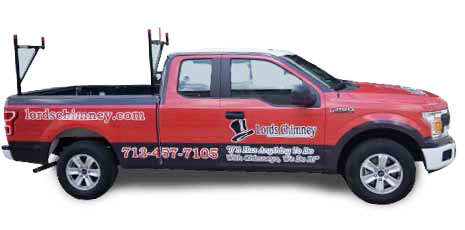Every time you burn wood in your fireplace or wood stove, condensation forms on your chimney’s flue. That condensation forms a dark, tar-like, highly combustible substance called creosote. When creosote builds up in your chimney, it can lead to a damaging and dangerous chimney fire, or it can force carbon dioxide back into your home, endangering your family.
Creosote sweeping logs promise a solution. They claim to reduce creosote buildup in your chimney simply by burning them in your chimney. Some such logs carry the seal of approval of the Chimney Safety Institute of America (CSIA), but even the CSIA acknowledges that the logs are not a replacement for your annual chimney sweeping and inspection by a CSIA-certified chimney sweep.
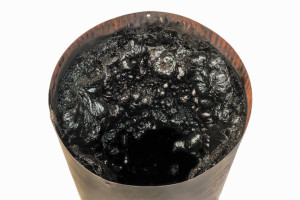
Creosote sweeping logs don’t remove all creosote
Creosote sweeping logs work by sending chemicals up your chimney that react with the creosote, causing it to flake away and fall back down your chimney to your firebox, where it either burns up or can be swept away. At best, the logs only remove up to 60 percent of the creosote from you chimney over a 15-day period. That means that creosote still can build up to dangerous levels within your chimney, blocking smoke from leaving your chimney and potentially igniting a chimney fire.
Additionally, many fireplaces aren’t a straight vertical channel. That means creosote can fall to and gather on your chimney’s horizontal surfaces, where it can build up. If your chimney is a straight vertical line, the creosote that falls into the firebox can cause flare ups that can harm your hearth or someone standing near it.
Creosote sweeping logs can’t spot problems with your chimney
Your annual chimney sweeping is more than just a cleaning. Your certified chimney sweep also inspects your chimney for structural damage, water leaks, crumbling mortar, and other problems. A creosote sweeping log simply can’t help you identify and solve problems with your chimney. Missing your annual chimney inspection gives small problems, like a minor leak, time to grow into a major problem that potentially will be expensive to repair.
More importantly, your certified chimney sweep looks for problems that could lead to a chimney fire or carbon monoxide poisoning. That includes animals that have nested in your chimney or chimney fires that have gone undetected.
Schedule your annual chimney sweeping today!
While the CSIA recognizes that creosote sweeping logs can be a valuable piece of chimney maintenance, eliminating some creosote in between professional chimney sweepings, replacing your annual chimney sweeping and inspection with a creosote sweeping log is dangerous both for your home and your family. If you’re overdue for your annual chimney sweeping and inspection, call the CSIA-certified chimney sweeps at Lords Chimney. We’ll make sure that your chimney is creosote-free and ready to burn safely this winter.
When it comes to fireplace and chimney service, installation, and maintenance, finding the right company to work with can be hard to do. With so many businesses to choose from, it can be difficult to determine the seasoned professionals from the seasonal workers.
Although anyone with a brush and a truck might be able to call themselves a chimney sweep, few have earned the Chimney Safety Institute of America, or CSIA, certification. By hiring a certified chimney sweep, you can feel confident that you are working with a highly trained and educated professional.
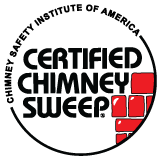
Are all chimney sweeps certified?
Many homeowners mistakenly believe that all chimney sweeps are created equally. Unfortunately, there are few regulations or restrictions on the industry. Because of this, any handyman with a couple of brushes can call themselves a chimney sweep. Oftentimes, these “chimney sweeps” do little more than push around the ash and soot in your chimney, making more of a mess than actually cleaning the chimney.
In order to get the best service possible for your fireplace and chimney system, it is important to work with a CSIA certified chimney sweep. The CSIA certification is recognized as the gold standard in the industry. Chimney sweeps that hold a CSIA certification have completed extensive education, training, and testing and represent the best in the industry in terms of skill and professionalism.
In order to earn their CSIA certification, chimney sweeps must study and be tested on topics such as:
- Fireplace and chimney safety practices
- Local and national building and fire codes
- Fireplace and chimney building dynamics for wide range of units
- Installation and maintenance practices for fireplaces, inserts, and stoves
- Current EPA standards for fireplaces, inserts, and stoves
CSIA certified chimney sweeps must also stay up to date on current industry practices. Because they must retest every three years in order to maintain their certification, CSIA-certified sweeps have information on the most recent safety and technology developments and best practices in the industry.
Hiring a certified chimney sweep
Because chimney maintenance can directly impact the safety of you and your family, it is important to work with a professional that you trust. Before hiring a chimney sweep, consider asking them the following questions:
- How long has your chimney sweeping company been in business?
- Can you offer current references?
- Do you have unresolved complaints filed with any consumer protection agencies or the Better Business Bureau?
- Does the company or the individual chimney sweep carry business liability insurance policy to protect my home and furnishings against accidents?
- Will the company guarantee that a CSIA Certified Chimney Sweep will be on my job site?
Don’t trust your family’s safety to the cheapest company you can find. Instead, hire a CSIA certified chimney sweep to ensure that your chimney’s maintenance and repairs are done correctly – the first time. In the Houston area, contact Lords Chimney to schedule an appointment with our CSIA certified chimney sweeps!
Your chimney does more than just decorate your roofline; it protects your entire fireplace system and helps keep you and your family safe. While chimneys are built to last and to withstand the elements, they can deteriorate due to damage, poor construction, or age.
In order to keep your chimney working well and in good condition it is important to be able to spot the signs of masonry damage. By knowing when your chimney is damaged, you can quickly enlist the help of a chimney professional to get it repaired and back in good working condition.
How masonry gets damaged

Masonry is one of the strongest building materials available, which is what allows well-built fireplaces and chimneys to stand the test of time. However, even the most well maintained masonry structures need repairs over time. Below are some of the most common causes of masonry damage, as well as what repairs can fix them.
Water: Water and moisture from rain, ice, and snow can be some of the most damaging forces that affect your chimney. Because bricks are naturally porous, they may absorb small amounts of water. As the water absorbed by the bricks freezes, it expands and creates progressively larger and larger cracks and holes. This freeze-thaw can cause significant damage to the masonry in as little as one year, causing bricks to crack, chip, and spall.
In addition to affecting the bricks and mortar of the chimney, water can affect many other parts of your chimney system. The chimney cap and crown are also particularly susceptible to water damage due to their location; many chimney leaks are caused by damaged chimney caps and crowns. Chimney leaks can lead to damage to the flue and firebox, as well as damage to the walls and ceilings surrounding your chimney.
One of the best ways to prevent water damage is by having your masonry waterproofed. The waterproofing process involves coating bricks and mortar with a specially designed chimney sealant. Made for porous bricks, it keeps water out while still allowing gasses to pass through. Waterproofing products can also be applied to chimneys with existing water damage to slow or stop the deterioration process.
Settling: Over time, all homes are prone to settling. Settling can affect many different parts of your home, including your fireplace and chimney. Masonry fireplaces that are not built on proper bases may become damaged due to settling; this often shows up as cracks in the firebox or chimney.
Chimney or fireplace cracks caused by settling can be repaired using the detailed tuckpointing process. Tuckpointing involves the removal of the existing damaged mortar, replacing it with new mortar that matches the color and consistency of the original. This strengthens the masonry and prevents further damage.
Subpar materials: Sometimes, chimney damage can be caused by the wrong materials. If subpar materials were used in the construction of your fireplace or chimney, it may be more prone to damage. Likewise, mistakes made during installation can also affect your fireplace system. This is often seen in fireplaces or chimneys that are built by general contractors rather than skilled masons.
No matter what is causing your masonry damage, it is important to have it repaired as soon as possible. Contact Lords Chimney today to schedule your masonry repair appointment!
Spring and summer rain showers and thunderstorms are often a welcome reprieve from the scorching temperatures. In addition to cooling us off, these rain storms also keep our lawns and gardens green and our rivers and lakes full and ready for summer fun.
Unfortunately, heavy rain can also lead to a leaky chimney. Chimney leaks are one of the most common chimney problems we see during the summertime. Even chimneys without previous problems can develop leaks – and their accompanying water damage – in as little as one season.
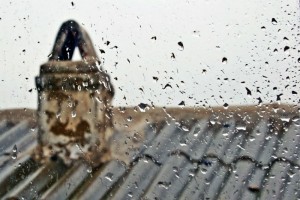
What causes chimney leaks?
Although chimneys look like simple brick or stone columns, they are actually complex structures with a number of different pieces and parts. Because the chimney is constantly exposed to the elements, its masonry is at greater risk for damage and breakdown.
The following are some of the most common causes of chimney leaks.
Chimney cap: The chimney cap protects the top of your flue from water entry, as well as animals and debris. Without a properly fitted chimney cap, the flue and fireplace are left completely exposed to water entry from rain.
Flashing: Flashing is the water tight strips that seal the seam between your roof and the chimney structure. If flashing is incorrectly installed, damaged, or merely loses its seal due to wear and tear or age, water can easily seep through any gaps. This can cause water damage to not only the roof and chimney, but also the ceilings and walls around the chimney.
Masonry damage: If one side or part of your chimney is often directly exposed to rainfall or other sources of water, the masonry may deteriorate or become damaged faster than the rest of the chimney. Water can cause bricks to crack and spall; in addition to making your chimney look aged or unkempt, it can also affect the structural stability of the chimney and lead to chimney leaks.
Symptoms of a leaky chimney
Many homeowners falsely assume that all leaky chimneys present themselves as visible water in the fireplace or flue. However, because of the size and complexity of most chimney systems, chimney leaks are often not recognized until they’ve already caused significant damage.
Below are some of the signs that may indicate your chimney is leaking.
- Water or condensation inside the firebox
- Sound of dripping water in the chimney
- Moisture, leaks, or water staining on walls or ceilings around chimney
- Musty or dank odors, especially after it rains
- Cracked or spalled interior or exterior masonry
Preventing chimney leaks
The best way to prevent chimney leaks is by having regular preventative maintenance done on your fireplace and chimney. Annual chimney sweepings and inspections can often identify any new chimney or masonry damage, allowing you to have it repaired before it leads to a chimney leak.
Another option for preventing leaks and water damage to your chimney is to have your masonry waterproofed. The waterproofing process involves the application of a specially designed sealant that keeps water out while allowing the masonry to retain its semi porous nature. These products can even be applied to chimneys with existing water damage as a way to keep it from getting worse.
If a summer rainstorm has left you with a leaky chimney, contact Lord’s Chimney today. Our expert staff can identify and resolve the source of your leaky chimney!
Gas fireplaces make a beautiful addition to any home and are an increasingly sought after feature for homebuyers. Valued for their beauty, functionality, and ease of use, more and more homeowners are converting their existing open hearth fireplaces to gas. However, what many may not realize is that their new gas fireplace is missing a required component – the damper stop.
Although many homeowners may not know what a damper stop is, they are a necessary part of a gas fireplace. Unfortunately, many homes with gas fireplaces – especially those that were not professionally installed – may be missing this important piece.
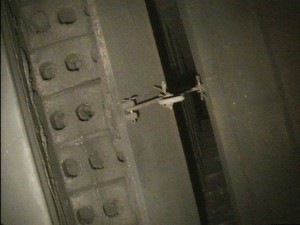
What is a damper stop?
A damper stop is a piece of metal designed to ensure that the flue of a gas fireplace always remains partially open. With a traditional hearth fireplace, the damper is opened or closed when the fireplace is in use.
While gas fireplaces also need the flue to be open while in use, there is often no mechanism to close it; instead, the damper is simply left partially or fully open when the gas insert is installed. However, leaving the damper open at installation does not ensure that the damper will stay open forever. Strong winds, house settling, or other damage to the flue or damper can cause the damper to close.
Because of this, damper stops were designed to be installed as a way to keep the damper permanently open. Although they are required, some homes with gas fireplaces – especially those that were self-installed by previous homeowners or untrained installers – may not have them.
Dangers of a missing damper stop
A damper stop may seem like an insignificant piece of the gas fireplace. However, it is a specially designed safety precaution that can help protect your family, namely against carbon monoxide poisoning.
Carbon monoxide is an odorless, tasteless, colorless gas that is often called the “silent killer” because it is so difficult to detect. When the damper is open, carbon monoxide is able to safely travel up the chimney and out of your home. However, if the damper is closed this deadly gas can back up into your room, affecting the health and safety of you, your family, and your friends.
How to identify a damper stop
With a traditional hearth fireplace, it is easy to tell if the damper is open or closed; if smoke back flows into a room when the fireplace is in use, the damper is closed. Gas fireplaces, however, do not produce smoke, making it much more difficult to tell if the damper is open or closed.
Missing damper stops are most frequently identified during home inspections; however, they can be easily missed, leading homeowners to believe that there is nothing wrong with their gas insert or fireplace.
To make sure that your gas fireplace has a damper stop that is correctly installed, contact Lord’s Chimney to schedule a chimney inspection. Our trained chimney sweeps will be able to inspect your chimney and fireplace to determine whether or not your gas fireplace has a damper stop; if it is missing, one can be installed. To make sure your chimney is up to current safety standards, contact us today!

